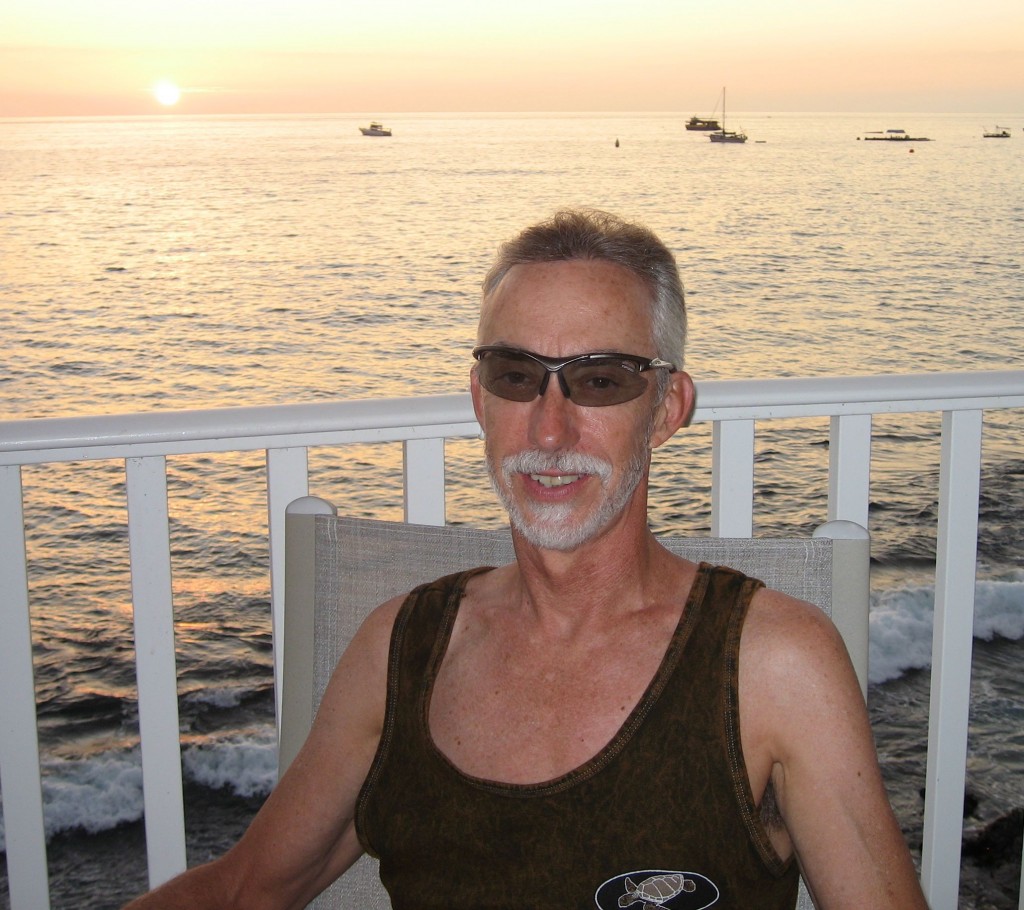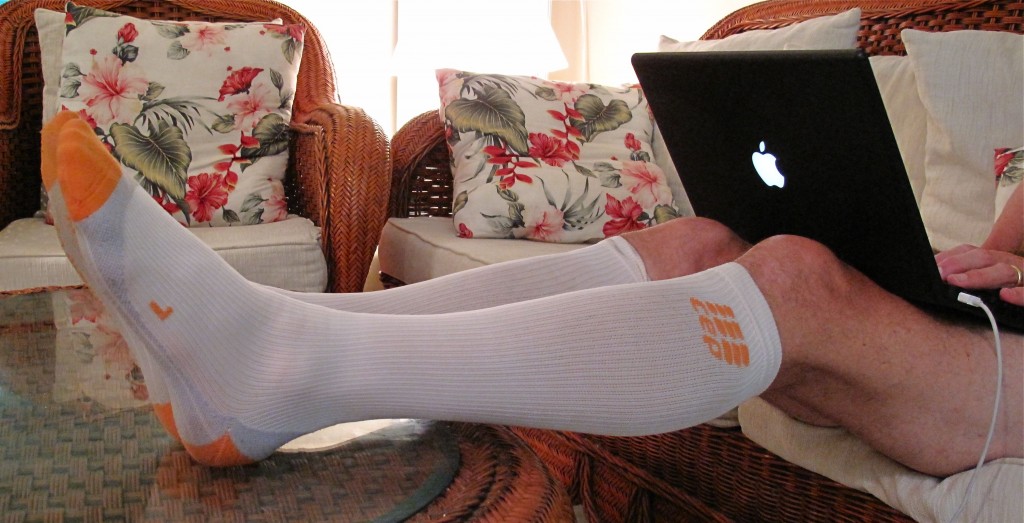“Are you ready?”
“I will be in 92 and a half hours.”
The volunteer, like most in the room, was a retiree living here on the Big Island. We were being herded into registration through a cattle chute. EVERYONE was here, and all had to go through the same line; in front of me were two pros, whose names I didn’t catch. And leaving as I entered was Miss Chrissie, smiling and tan.
“She looks much better in real life than she does in pictures,” Cheryl said, who should know a thing or two about pictures. It’s true; poor Chrissie Wellington was born with flyaway kinky hair and smallish eyes easily hidden by the crinkles around them. But in motion, her face has a much warmer cast, and her eyes smile along with the rest of her.
Anyway, I do not like to think I’m ready until about ten minutes before the swim, or even later. I’ve got a meticulous plan for the last few days, and all the pieces need to fall in place, starting with the final workouts, which came today. Wednesday and Friday, I will do some swim/bike/run, but more to shake the nerves free than hope to learn anything.
This morning, we swam for about 20 minutes in Kailua Bay. It was a mad house. On race day, of course, the route is very clear, and we are all going in the same direction, along the same line. Now, it’s chaos. As long as one stays clear of the small boat anchor area, you can swim anywhere you want. Near miss head-on collisions are common. Most everyone is gunning their engines, barreling along with massive outboard motor kicks and windmill arm-strokes. I’m Mister Slow and Smooth, hopefully saving a bit for race day. After all, I have been swimming for fifty years now, and don’t feel the need to blast out a few anaerobic sprints. But I’m also slower than the majority of the people in the water, which is disconcerting in some ways. Usually, I finish am IM in the top 20%; at this race, I’ll be doing well if less than 75% of the racers finish ahead of me.
As I exit onto Dig Me Beach, Paula Newby-Fraser, the original Queen of Kona and holder of a record 8 titles and the fastest women’s time here, is standing around with four other middle-aged women, chatting away, Of course, to call them “middle-aged” might give the wrong impressions. Paula does not seem to have gained an OUNCE since her racing days were over, and she is nearly 50 now. She is what I would euphemistically call “slender”. Others might term it “athletically anorectic”. Asthenic?
Then, Cheryl and I took in a lecture at the Ironman Sports Medicine conference. Basically we learned that Chrissie Wellington ate 86 grams of carbs per hour (and a bit of protein) during her race two years ago, and that caffeine, at a dose of about 200 mg for someone my size, is a definite ergonomic aid. If you can get past the jitters.
Next, back down to the pier, and into the King Kam hotel. We gobbled up a few Ironman logo’d clothing items for ourselves and for gifts (not saying what or for whom!) Then, into line for the magic bracelet, firmly identifying me as a member of the tribe (for this year at least) of those who are racing on Saturday in West Hawaii at the IM World Championship. The bracelets used to all look alike, and were some very flashy bright neon colored so we could easily spot each other. This year, though, there was a big brouhaha that led to a change in the bracelets. Only in the world of triathlon would this story make any sense, but I’ll try anyway.
Three years ago, a very fast biker named Torbjorn Sindballe determined to improve on his Kona finishes. He is a large man, well over six feet tall, and thus running in the heat (big people have a harder time cooling off than smaller ones). So he developed a running outfit which consisted of white fabric covering most of his body. The clothes were very form fitting, to aid in evaporating his sweat. For his legs, he wore compression socks, the kind old men use to help with varicose veins. He finished third that year, and a new marketing niche was born.
At least 7 different companies came out with compression socks for the triathlon and running markets. They expounded theories that this would improve performance by increasing the return of blood from the legs to the central core. As if the muscle pumping of running, and tripling your heart rate weren’t doing that well enough already?! Whatever. I myself have a pair of these, but I don’t race in them. I use them on airplanes, especially after a race, to prevent blood clots, and also in the evening after a very strenuous workout, because they just feel good. In fact, I think I’ll go put them on right now.
There, that feels better. Notice the “L”? That stands for “left” – these are leg-specific! Where was I? Oh yeah, the bracelets. Well, people started wearing the socks in races, which was all right – they don’t look any sillier than aero helmets or heart rate monitor straps. But the thing is, triathletes get “body-marked”, with our race number and our age. The age traditionally goes on the calf. This is so, if you are gaining on someone (or if they pass you), you can determine if he’s in your age group, and therefore your competition. This is a race, after all. But the socks were covering the age markings, and this raised a stink among the antsier members of our fraternity. I never heard any women complain about it, though.
So, for this race, Ironman included the following rule: “Any garment, such as tights, compression socks, tube socks, medical tape [a whole other area of athletic silliness], etc. that conceals body marking on the calves, will not be permitted.”
Well. THAT raised a stink. Within days, they rescinded the rule, and were left pondering how to identify our age groups. This may be a temporary solution, but our bracelets are each a different color – 14 of them, 12 age groups, pros, and challenged athletes. Men and women have the same color, as, presumably, we can detect if someone is the same gender as we are or not. I am a sort of light, bluish teal, close to the color on the Group Health logo.
So, problem solved? I doubt it. See, I routinely wear a sweat band on the same wrist as my bracelet, on both the bike and the run. This is for (gross out alert!) my nose, which leaks constantly when I exercise, even in warm weather. So I use the sweat band to wipe my nose off. Otherwise … well, let’s just stop here. If they don’t require me to exhibit the bracelet while I’m competing, I’ll just keep doing what I’ve been doing. We do have to show the bracelet for lots of other things – to get into the pre and post race banquets; to get into the transition area; to claim our bike; to identify ourselves if we pass out, drown, get hit by a falling lava rock, etc.
As I said, only in triathlon would this story make any sense.
As to the rest of my day, well, Cheryl swam in A-Bay while I tackled the Queen K from Waikoloa to Veteran’s Cemetery. This is the windiest, hottest and sunniest part of the course, comes at mile 90-102, and involves the last real hill of the bike course. These elements conspire against any attempts to settle into an aggressive frame of mind. I figure, the more times I can ride this, the more familiar I will be with the landmarks, and therefore the less I will need to think about where I am and where I’m soon to go, and I’ll be able to concentrate more closely on actually working my bike in the moment against the hill and the wind. I hope.
Then, we drove to the Energy Lab, for another try at this equally critical part of the run course. Miles 16.5-19.5. Hill, sun in your face or at your back, possibly a tailwind while going up hill (which feels like no wind, at running speeds), incorporating the classic elements of “the wall” in a marathon. So, again, familiarity may breed contentment.
I hit these sections today at Ironman effort level, and my speed was reassuring, averaging over 19 mph on the bike, and a tick under nine minute miles on the run. Good signs for a 6 hour bike (if the winds cooperate!), and a 4:10-15 run.
Then home to sunset, and salmon on the grill.


